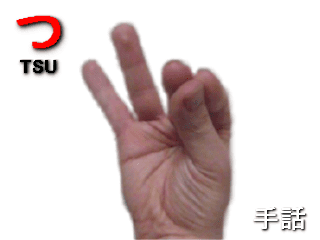ISO 639-3 jsl | Native speakers 320,000 (1986) Glottolog japa1238 | |
 | ||
Language family Japanese Sign Language familyJapanese Sign Language Regulated by | ||
Japanese Sign Language (日本手話, Nihon Shuwa), also known by the acronym JSL, is the dominant sign language in Japan.
Contents
History
Little is known about sign language and the deaf community before the Edo period. In 1862, the Tokugawa shogunate dispatched envoys to various European schools for the deaf but the first school for the deaf was not established until 1878 in Kyōto.
Until 1948, deaf children were not required to attend school to receive a formal education.
In the second half of the 20th century, a subtle cultural change in views about the Deaf in Japan evolved. The long-standing concept that "deaf" only means "people who can't hear" emphasized a physical impairment as part of a biomedical disease model; however, this was gradually replaced by a slightly different paradigm. "Deaf people" were more often identified as "people who use Japanese sign language". In other words, the biomedical disability model began slowly to be displaced by a social-cultural or JSL paradigm.
The Japanese Federation of the Deaf has worked with slow success in efforts to enhance communication opportunities for Japanese whose primary language is JSL.
The changing status of JSL and the Deaf in Japan is a slow process; but there are highlights. For example, JSL has an advocate among the Imperial family. Kiko, Princess Akishino has studied JSL and is a trained sign language interpreter. She attends the Sign Language Speech Contest for High School Students held every August, and Praising Mothers Raising Children with Hearing Impairments every December. In October 2008, she participated in the 38th National Deaf Women's Conference. She also signs in informal Deaf gatherings.
The Deaf community supported passage of the proposed Sign Language Law. The "Basic Act for Persons with Disabilities" was enacted in 2011. This law recognized sign language as a language.
Japanese Sign Language interpreters
The slow integration of JSL within the context of Japanese culture has been accompanied by an expansion of the numbers of sign language interpreters:
In 2006, the Japanese government amended the Supporting Independence of People with Disabilities Act. The new language in the law encourages local governments to increase the number and use of JSL interpreters.
Elements of Japanese Sign Language (JSL)
As in other sign languages, JSL (usually called simply 手話 shuwa, "hand talk") consists of words, or signs, and the grammar with which they are put together. JSL signs may be nouns, verbs, adjectives, or any other part of a sentence, including suffixes indicating tense, negation, and grammatical particles. Signs consist not just of a manual gesture, but also mouthing (口話, kōwa, "mouth talk") (pronouncing a standard Japanese word with or without making a sound). The same sign may assume one of two different but semantically related meanings, as for example in "home" and "house", according to its mouthing. Another indispensable part of many signs is facial expression.
In addition to signs and their grammar, JSL is augmented by yubimoji (指文字, "finger letters"), a form of fingerspelling, which was introduced from the United States in the early part of the twentieth century, but is used less often than in American Sign Language. Each yubimoji corresponds to a kana, as illustrated by the JSL syllabary. Fingerspelling is used mostly for foreign words, last names, and unusual words. Pantomime (身振り, miburi, "gestures") is used to cover situations where existing signs are not sufficient.
Because, like the standard Japanese from which it partly derives, JSL is strongly influenced by the complex Japanese writing system, it dedicates particular attention to the written language and includes elements specifically designed to express kanji in signs. For either conciseness or disambiguation, particular signs are associated with certain commonly used kanji, place names, and sometimes surnames. Finger writing (空書, kūsho, "air writing") (tracing kanji in the air) is also sometimes used for last names or place names, just as it is in spoken Japanese.
Other sign languages in use in Japan
Besides JSL there are also Pidgin Signed Japanese and Signed Japanese. Both of these are signed forms of the Japanese language. The first is used between non-native signers, and the latter is sometimes used in schools for the deaf. However, up to 2002, most Japanese schools for the deaf emphasized oral education, i.e. teaching through lip-reading. Even now, at least officially, JSL is not taught. It has been only a decade since the official school ban on the use of JSL was lifted.
The sign languages of Korea and Taiwan share some signs with JSL, perhaps due to cultural transfer during the period of Japanese occupation. JSL has about a 60% lexical similarity with Taiwanese Sign Language.
Diffusion of JSL among the hearing
Interest in sign language among the hearing population of Japan has been increasing, with numerous books now published targeting the hearing population, a weekly TV program teaching JSL, and the increasing availability of night school classes for the hearing to learn JSL. There have been several TV dramas, including Hoshi no Kinka (1995), in which signing has been a significant part of the plot, and sign language dramas are now a minor genre on Japanese TV.
The highly acclaimed 2006 Alejandro González Iñárritu–directed multiple Academy Award–nominated film Babel also featured JSL as a significant element of the plot. Hearing actress Rinko Kikuchi received a Best Supporting Actress nomination for her signing role in this film.
In Japan, about 40,000 signatures including both the hearing and deaf people have been collected to subtitle the scene in Babel spoken in Japanese for the deaf audience.
